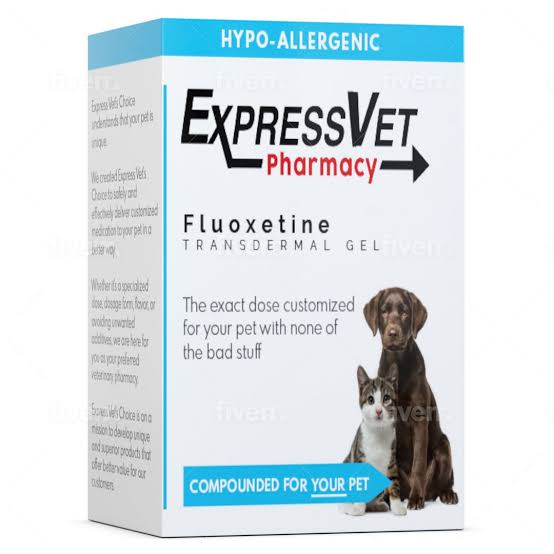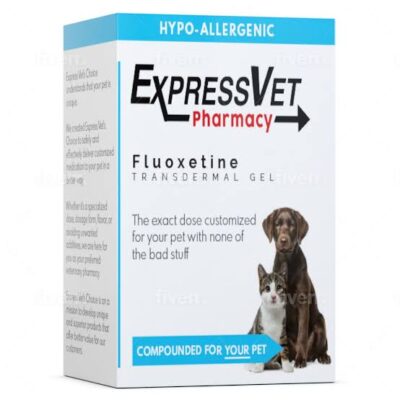
Fluoxetine, commonly known by its brand name Prozac, is a selective serotonin reuptake inhibitor (SSRI) widely used in human medicine to treat anxiety, depression, and other mental health conditions.

Over the years, fluoxetine has also become an important part of veterinary medicine, used to treat a variety of behavioral and psychological conditions in pets, including cats. However, pet owners often wonder if fluoxetine is safe for cats and how it can be used effectively.
This article will explore the safety, uses, potential side effects, and important considerations when it comes to giving fluoxetine to cats. Additionally, we’ll discuss how fluoxetine works, the conditions it treats, and answer frequently asked questions to provide a comprehensive overview for concerned pet owners.
What is Fluoxetine?
Fluoxetine is a type of antidepressant that belongs to a class of drugs called selective serotonin reuptake inhibitors (SSRIs). SSRIs work by increasing the levels of serotonin, a neurotransmitter in the brain that plays a crucial role in regulating mood, behavior, and emotions.
By inhibiting the reuptake of serotonin, fluoxetine helps maintain its availability in the brain, which can improve mood and reduce anxiety.
While fluoxetine is most commonly associated with treating depression in humans, it has also been found effective for treating various behavioral issues in animals, including cats.
In veterinary medicine, fluoxetine is used to manage conditions like separation anxiety, compulsive disorders, and other forms of behavioral distress that can negatively impact a cat’s well-being.
How Does Fluoxetine Work in Cats?
Fluoxetine works in cats similarly to how it works in humans. It targets serotonin receptors in the brain to regulate serotonin levels, which can improve mood, reduce anxiety, and help control compulsive behaviors. In cats, fluoxetine is typically prescribed for its calming and mood-stabilizing effects.
The medication influences a cat’s brain chemistry by:
1. Increasing serotonin availability: Serotonin is a neurotransmitter that regulates mood and anxiety. By preventing its reuptake, fluoxetine ensures more serotonin remains in the brain, helping to reduce anxiety and improve mood.
2. Modulating emotional responses: Cats that suffer from anxiety or compulsive behaviors may have an imbalance in the serotonin system. Fluoxetine helps normalize this balance, reducing behaviors like excessive grooming, aggression, or inappropriate urination.
3. Addressing behavioral issues: Fluoxetine is often prescribed for cats with behavioral problems that are not easily managed through environmental changes or other behavioral training methods.
While fluoxetine can be highly effective, it is important for pet owners to remember that it may take several weeks to see the full effects of the medication. Cats do not always respond immediately to treatment, and adjustments to the dosage may be necessary for optimal results.
Conditions Fluoxetine Treats in Cats
Fluoxetine is primarily used to manage a variety of behavioral and emotional conditions in cats. These include:
1. Separation Anxiety
Separation anxiety is a common behavioral issue in cats, particularly when they are left alone for extended periods. Symptoms of separation anxiety in cats include excessive vocalization, destructive behavior, inappropriate urination or defecation, and pacing. Fluoxetine can help reduce the symptoms of separation anxiety by calming the cat and making them less stressed when left alone.
2. Compulsive Behaviors
Fluoxetine is also prescribed for cats exhibiting compulsive behaviors such as excessive grooming, tail-chasing, or self-mutilation. Cats with these behaviors often do so in response to stress, anxiety, or boredom. Fluoxetine helps to manage these compulsive behaviors by reducing the anxiety that triggers them and promoting a calmer mental state.
3. Aggression
Aggressive behavior in cats can sometimes be related to anxiety or fear. Fluoxetine can help manage aggression by reducing the underlying anxiety and promoting a more balanced mood. This is especially helpful in multi-cat households or situations where aggression is directed toward people or other pets.
4. Urine Marking and Inappropriate Elimination
Fluoxetine may be prescribed for cats who urinate outside the litter box, especially when the behavior is linked to stress, anxiety, or territorial issues. The drug can help to reduce the anxiety that causes the inappropriate elimination behavior, making it easier for the cat to adjust to a new environment or changes in routine.
5. Fear-Related Behaviors
Some cats are particularly sensitive to stimuli in their environment, such as loud noises, new people, or changes in routine. Fear-related behaviors like hiding, excessive vocalization, and aggression toward perceived threats may be alleviated with fluoxetine. The medication helps to calm the cat’s anxiety and prevent fear-based reactions.
Dosage and Administration of Fluoxetine for Cats
Fluoxetine is typically prescribed in oral form, either as a tablet, capsule, or liquid suspension. The appropriate dosage depends on the specific condition being treated, the cat’s weight, and overall health. The typical dose for cats ranges from 0.5 to 2 mg per pound of body weight, given once daily. For cats with severe behavioral issues, the veterinarian may adjust the dosage based on the cat’s response to the medication.
It is important to follow the veterinarian’s instructions regarding dosage and administration carefully. Fluoxetine should be administered consistently at the same time each day to ensure its effectiveness.
Fluoxetine may be taken with or without food, but some cats may experience mild gastrointestinal upset when the medication is given on an empty stomach. If this occurs, it may be helpful to administer the medication with a small amount of food.
READ ALSO: When to Use Metronidazole for Dogs
Side Effects of Fluoxetine in Cats
While fluoxetine is generally safe for cats, it can cause side effects in some animals. The most common side effects include:
Gastrointestinal upset: This may include nausea, vomiting, diarrhea, or decreased appetite. These symptoms are often mild and can be reduced by administering the medication with food.
Sedation or lethargy: Some cats may experience drowsiness or lethargy when taking fluoxetine, particularly during the initial stages of treatment.
Behavioral changes: While fluoxetine helps manage anxiety and compulsive behaviors, some cats may experience a temporary increase in anxiety, restlessness, or agitation, especially during the first few days of treatment.
Changes in activity level: Some cats may become more active or restless as a side effect of fluoxetine, while others may become more sedate.
Rare side effects: In very rare cases, cats may develop more severe side effects such as seizures, changes in heart rate, or serotonin syndrome (a rare but serious condition caused by excessive serotonin levels). These require immediate veterinary attention.
If any side effects are noticed, particularly severe symptoms like seizures or aggression, it is important to contact a veterinarian immediately.
Important Considerations and Warnings
Interactions with other medications: Fluoxetine can interact with certain other medications, including other antidepressants, certain pain relievers, and medications that affect serotonin levels. Always inform your veterinarian of any other medications or supplements your cat is taking.
Pregnancy and lactation: Fluoxetine should only be used in pregnant or lactating cats if the benefits outweigh the risks. Consult your veterinarian if your cat is pregnant or nursing before starting treatment.
Monitor your cat’s progress: Fluoxetine may take several weeks to show its full effects, so it is important to monitor your cat’s progress and report any changes in behavior to the veterinarian. In some cases, the dosage may need to be adjusted.
Long-term use: While fluoxetine is typically prescribed for long-term use, your veterinarian may periodically reassess the need for continued treatment and adjust the dosage accordingly.
FAQs
Is fluoxetine safe for cats?
Yes, fluoxetine is generally safe for cats when prescribed and monitored by a veterinarian. It is commonly used to treat behavioral conditions like anxiety, compulsive behaviors, and aggression. However, side effects can occur, and it is important to follow the veterinarian’s dosage instructions closely.
How long does it take for fluoxetine to work in cats?
It can take 2-4 weeks to notice the full effects of fluoxetine in cats, although some cats may start to show improvement in as little as one week. It is important to be patient and continue administering the medication as prescribed.
What should I do if I miss a dose of fluoxetine?
If you miss a dose, give it as soon as you remember. If it’s almost time for the next dose, skip the missed dose and continue with the regular schedule. Never give two doses at once.
Can fluoxetine cause my cat to become more aggressive?
While fluoxetine generally helps reduce aggression, some cats may initially experience an increase in agitation or restlessness, especially during the first few days of treatment. If aggression persists or worsens, consult your veterinarian for further guidance.
Can I stop giving fluoxetine to my cat if they seem to feel better?
Do not stop giving fluoxetine to your cat without consulting your veterinarian. Abrupt discontinuation can lead to a relapse of the behavioral issues or withdrawal symptoms. If you believe your cat no longer needs the medication, speak with your veterinarian about gradually tapering the dose.
Leave a Reply
You must be logged in to post a comment.